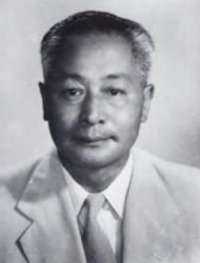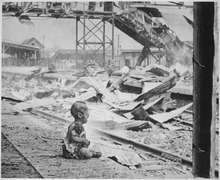H. S. Wong


H. S. "Newsreel" Wong (1900 – March 9, 1981) was a Chinese newsreel photojournalist. He is most notable for "Bloody Saturday",[1] a moment he captured on film during the Second Sino-Japanese War.
Wong was also known as Wang Haisheng (Chinese: 王海升) or Wang Xiaoting (Chinese: 王小亭).[2] He owned a camera shop in Shanghai.[1] For capturing moving images he used an Eyemo newsreel camera, and for still photography he used a Leica.
Career
In the 1920s and 1930s, H. S. Wong worked in China and provided photographs and films for various newspapers and agencies, such as Hearst Metrotone News and Shanghai News.[2][3] Wong's most famous photo, "Bloody Saturday" or "Shanghai Baby", was taken during the Battle of Shanghai in the Second Sino-Japanese War. It shows a baby sitting up and crying amid the bombed-out wreckage of Shanghai South Railway Station.[2][3] Within a year of its publishing, the photo was seen by more than 136 million people.[4] In 2010, Wong was honored as a pioneering Asian-American journalist by the Asian American Journalists Association.[5]
Wong filmed more newsreels covering Japanese attacks in China, including the Battle of Xuzhou in May 1938 and aerial bombings in Guangzhou in June.[6] At times, he placed himself in danger to get a photo; once was subjected to bombing and strafing by Japanese aircraft.[7] After angering the Japanese by documenting the violence of their attacks, the Japanese government put a bounty of $50,000 on his head.[8] In China, he operated under British protection, but continued death threats from Japanese nationalists drove him to leave Shanghai with his family and to relocate to Hong Kong.[9]
Later life and death
Wong retired to Taipei in the 1970s and died of diabetes at his home at the age of 81 on March 9, 1981.[10]
References
- 1 2 "Cinema: Shanghai, Shambl". Time. Time, Inc. September 13, 1937.
- 1 2 3 "王小亭 1900~1983". 《他們是歷史的目擊者》─民國40年代台灣攝影記者作品展 (in Chinese). imagecoffee.net. Retrieved 9 July 2011.
- 1 2 邢定威 (2005-09-01). "王小亭"觀看"的力量" (in Chinese). 台灣記協 (Association of Taiwan Journalists). Retrieved 9 July 2011.
- ↑ Van der Veen, Maurits (2003). Uriel's Legacy. Trafford Publishing. p. 262. ISBN 1-55395-462-9.
- ↑ "Honor Roll List: Pioneers, past and present". Asian American Journalists Association. December 24, 2010. Retrieved January 18, 2011.
- ↑ "Library Contents Listed Year-by-Year: 1938". The 1930s: Prelude to War Video Library. UCLA Film and Television Archive. Retrieved January 18, 2011.
- ↑ Ezickson, A. J. (1938). Get That Picture! – The Story of the News Cameraman. New York: National Library Press. p. 148.
- ↑ French, Paul (2009). Through the looking glass: China's foreign journalists from opium wars to Mao. Hong Kong University Press. p. 192. ISBN 962-209-982-3.
- ↑ Faber, John (1978). Great news photos and the stories behind them (2 ed.). Courier Dover Publications. pp. 74–75. ISBN 0-486-23667-6.
- ↑ "'Newsreel' Wang succumbs at 81". Taiwan Today. Government Information Office, Republic of China (Taiwan). May 1, 1981. Retrieved January 18, 2011.